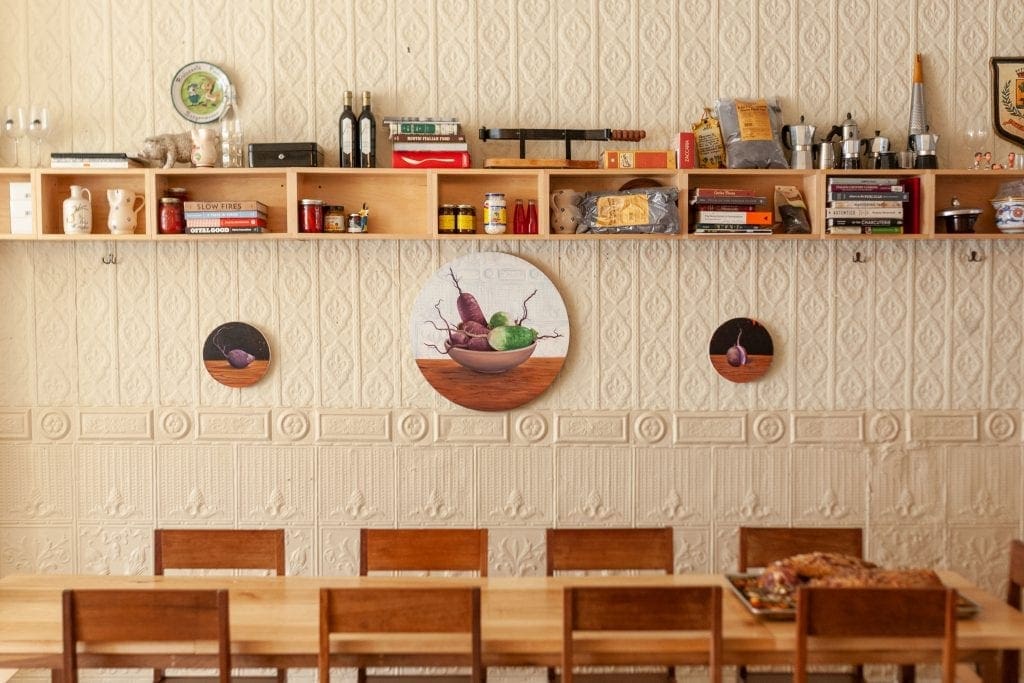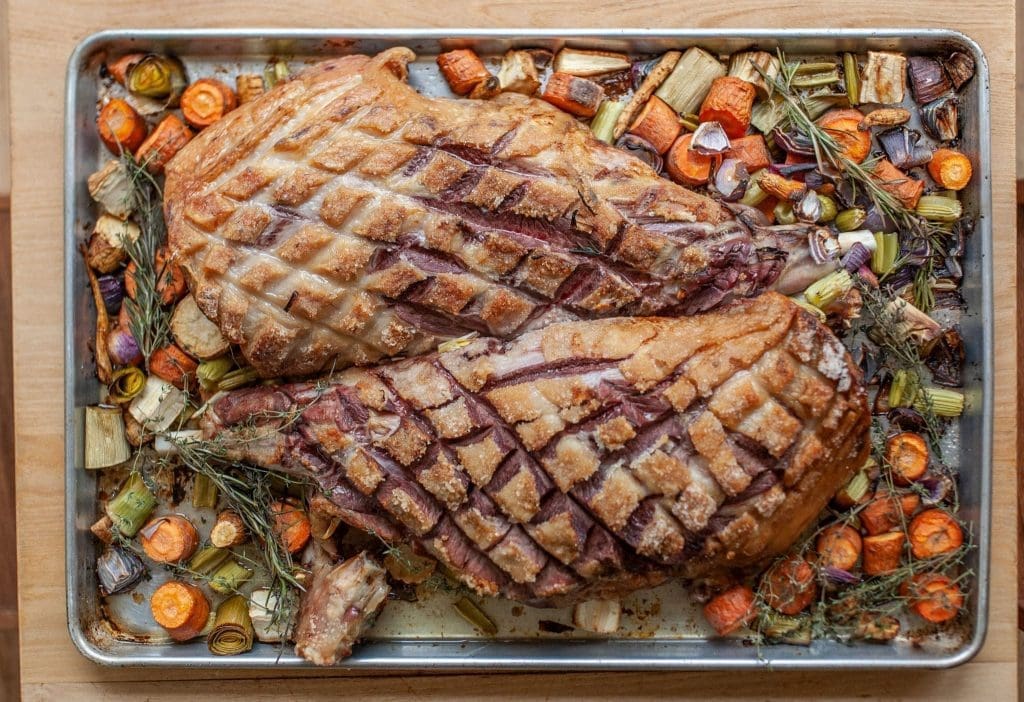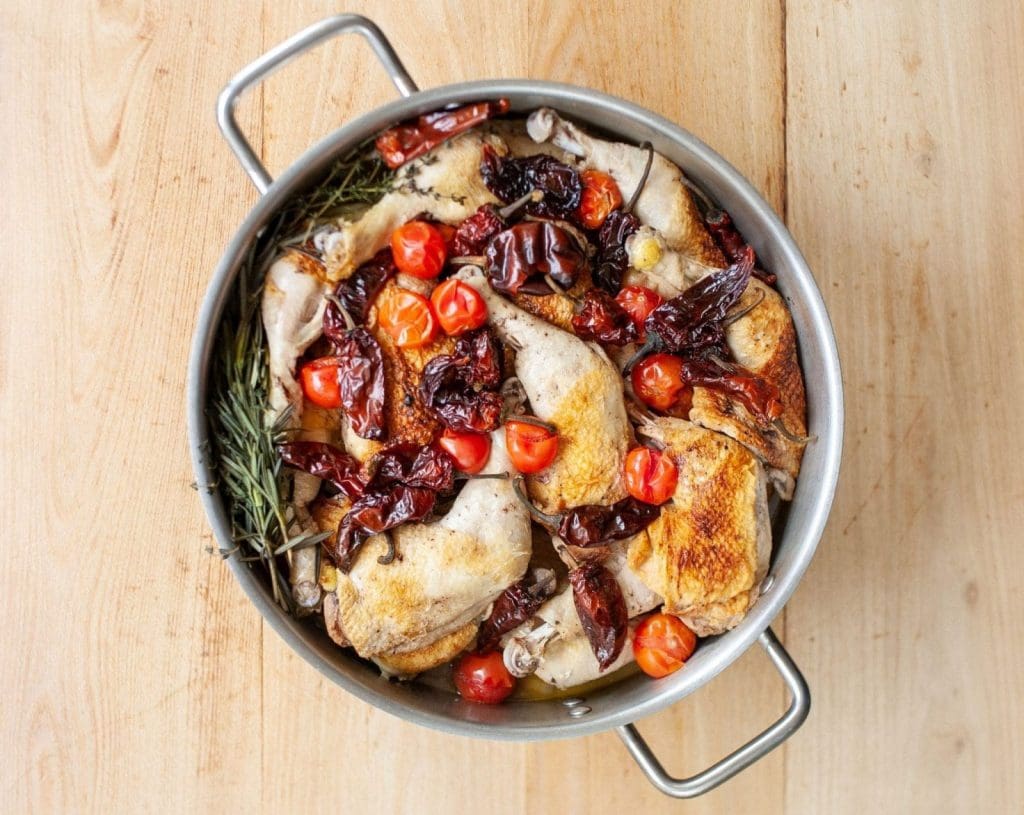—At Corto in Jersey City, they’re paying homage to the traditions of cucina povera, Italy’s most humble and resourceful cuisine. In 2021, this style of conscious, pantry-heavy cookery has never mattered more.
Throughout history, times of hardship and strife were often the genesis of a shift in culinary habits. After all, necessity has long been the mother of invention. During the pandemic, while we were at home digging through our pantries with a “make-more-with-less” mentality, I couldn’t help but be reminded of the ethos sparked by another crisis.
Cucina povera, translating to poor kitchen, refers to the approach to cooking that emerged from a post-World War II Italy. It’s not so much a style of cuisine as it is a philosophy—one where natives had to essentially “make do” with what was in the cupboard, what they grew and what they could afford. No scrap left unused. No ingredient too humble. Meats were cured in order to sustain the winter, and the bones, used for soups. Stale, leftover loaves were turned into breadcrumbs. Potatoes and flour, combined to form gnocchi.
Cucina povera is a great example of how constraint can incite creativity. Perhaps that’s why, at least to me, it feels more relevant today than ever. Before I ever heard the term or knew its origin, I had slipped my fork into dishes with its underpinnings. Not in Italy, but in the rather unsuspecting Heights neighborhood of Jersey City.

I arrived at Corto on the Tuesday after Valentine’s Day weekend. Any other year, the aftermath would’ve been impossible to conceal. In 2021, chef-partner Matt Moschella is apologizing for the holiday’s remnants, referencing the scattered tables on the restaurant’s backyard patio—a set-up that’s become crucial to Corto’s business. Maybe it’s all the time I’ve spent indoors, but I admittedly couldn’t envision the chaos.
This wasn’t my first time sitting down at a table at Corto, but it was my first time getting to speak with Moschella, who is usually hunched over the counter that separates the restaurant’s dining area and kitchen. He’s just pulled a leg of lamb out of the oven, and it takes everything in me to keep my focus. I’ve had this dish before, but I’ve never seen it in its whole form. Enormous, simply roasted, laying on a bed of rosemary and rough-cut vegetables. A showstopper you’d place at the center of a table on a special occasion. Precisely what Moschella and his partners, Marc Magliozzi and Drew Buzzio, envisioned when opening Corto in 2018.

“The decision to go with the cucina povera concept was because that’s the food we grew up eating, the humble foods that our parents made or that we would look forward to at family gatherings,” Moschella explained. “Those sort of foods felt underrepresented, especially right here outside of New York City where haute cuisine reigned supreme up until the pandemic.”
To Moschella’s point, Corto couldn’t fall further from the frou-frou of fine dining. However, that’s not to say the work they’re doing is any less inspired. As a chef, Moschella is often able to get his point of view across using only five ingredients, none of which have been contorted or manipulated far from their original form. He transforms humble mushrooms into a filling for light as air agnolotti with porcini brodo. He drapes thinly sliced lardo over beetroot with red pesto, almonds and mint. The ruffled edges of mafaldine, long ribbons of perfectly-made pasta, hold just Grana Padano, black pepper and speck.
As a restaurant, Corto inhabits the bones of an old bodega on Palisade Ave., a space chosen to deliberately resemble the likes of your grandmother’s house. Filled with custom wood tables, chairs and tin walls painted over in a creamy white color, you can literally see the generations that influenced Corto’s concept. Photos of the trio’s ancestry are on display in perfectly crooked, mismatched frames and self-portraits of Moschella, Magliozzi and Buzzio hang near the kitchen. It’s that kind of homey aesthetic and sense of community that the partners set out to cultivate—a celebratory ambiance.

“We’ve experienced great support from The Heights. I live in this community, and so do both of my partners. I’m raising my family here. Our intention wasn’t to open a run-of-the-mill restaurant that caters to a larger population, but to focus on really providing for our neighborhood,” said Moschella.
Up until March 2020, Corto did just that. Their interactive chef’s counter offered a tight bond between staff and restaurant regulars. Their communal tables forged relationships between friendly-faced strangers. And the food, sourced locally whenever possible. Fresh seafood was (and is still) provided daily by Local 130 based out of Asbury Park. The cured meats come directly from Salumeria Biellese in Hackensack, owned and operated by Buzzio’s family. The aforementioned lamb, out of a nearby farm in Pennsylvania.
Although cucina povera is defined as a poor kitchen or “peasant cooking,” that doesn’t mean Corto is cutting any corners. They’re using high-end ingredients and allowing what’s in season to dictate their menu. “The idea is in line with the philosophy of utilizing everything that you have and being able to reach to the pantry, rather than selecting overabundant items or having something provided that’s out of season. We’d prefer to see what’s available first and create from there, similar to a weeknight meal,” explained Moschella.
When he says reach to the pantry, he actually means it. Look around, and you’ll notice Bianco DiNapoli tomatoes and other canned goods on Corto’s dining room shelves. These are the actual ingredients Moschella uses in his dishes, and the few exceptions that they import.

“Sometimes, if you read about cucina povera, it might require or reference an ingredient that’s indigenous to Italy. So whenever possible, we find that there are comparable options here in New Jersey, the tri-state area and Pennsylvania. We have a preparation of a whole sea bream, similar to a branzino, and instead of having it shipped frozen from the Mediterranean, we’re able to support local fisherman while simultaneously offering customers something that’s been out of the water for 24 to 36 hours.”
Corto’s menu is also beloved for sentimental reasons. The ricotta toast, flecked with pink peppercorns and dressed with wildflower honey and olive oil, has evolved from customer favorite to permanent fixture. Spaghetti, Moschella’s favorite, carries with it anchovy, garlic, capers, peperoncino, colatura and breadcrumbs. A hearty slice of crusty bread serves as the vehicle for the signature Angry Chicken, a piece of poultry so fall-off-the-bone tender, you’ll wonder why more restaurants aren’t preparing it this way.
Cue the onset of the pandemic in March 2020, and Corto was presented with a dilemma unlike any other they’ve encountered. Their chef’s counter was no longer. Communal seating was out of the question. No more indoor dining, period. Moschella remembers getting the call to shut down on a Sunday, and by Tuesday, they were offering an abbreviated to-go menu. As if times weren’t hard enough, a tougher pill to swallow for Moschella was picturing first-time customers having their initial introduction to Corto be through carryout or delivery.

“We had never really emphasized to-go. Off the radar, we had allowed phone calls for carryout but we never promoted it. When we transitioned to a to-go business model only, we didn’t offer any of our ready-to-eat pastas. We didn’t want them to become mushy or something other than what we strive to provide. That’s when the pasta kits became an idea. Another aspect of that decision was the experience. We’re a sit-down restaurant, so I knew that part of our business was being cut out. We were only able to offer food, so we wanted to be able to reintroduce an activity and get the customers involved by cooking at home.”
Call it a silver lining, but pasta kits and an online marketplace forced Moschella and his partners to discover an entirely new aspect to their businesses—one that catered to customers during lockdown and has remained available to those who aren’t quite comfortable returning to the restaurant just yet. “Once outdoor dining came back in June [2020], we stopped the to-go business but the pasta kits and market still live on. As I mentioned, this community has really been supportive of us, so I definitely felt a responsibility to maintain a level of accessibility for everyone, despite their health concerns.”

Corto’s outdoor space is one Moschella acknowledges they’re fortunate to have, and without it, it no doubt would’ve been a very different year. However, he admits it was previously viewed more so as an amenity during the summertime. In the past, Corto hosted pig roasts out there and used the patio for an on-site garden, with the exception of a few dining tables. For the better part of 2020, and up until the foreseeable future, it’s become their livelihood.
“Now we’re actually facing a new challenge, but a very good one. As the restrictions for indoor dining start to lift, and people gradually feel more comfortable coming out, we’ve essentially created twice as many seats and our kitchen currently isn’t capable of doubling its output. We’re already pretty busy as it is, so we’re going to have to learn and understand what our limitations are, but I think we’ve come out of this pandemic stronger.”
After speaking with Moschella, I would have to agree. Embracing constraint, a cornerstone of cucina povera, is what this year has been all about. And for a restaurant like Corto, it’s a seed that was planted before the coronavirus arrived. The ability to adapt, look inward and reinterpret, it seems, could be the way forward.
Main image of the Angry Chicken, photography by Peter Bonacci
Abby is The Digest's Managing Editor. She spends her time looking at dogs on Instagram and eating her way around Jersey City.
- Abby Montanezhttps://thedigestonline.com/author/abby/
- Abby Montanezhttps://thedigestonline.com/author/abby/
- Abby Montanezhttps://thedigestonline.com/author/abby/
- Abby Montanezhttps://thedigestonline.com/author/abby/


